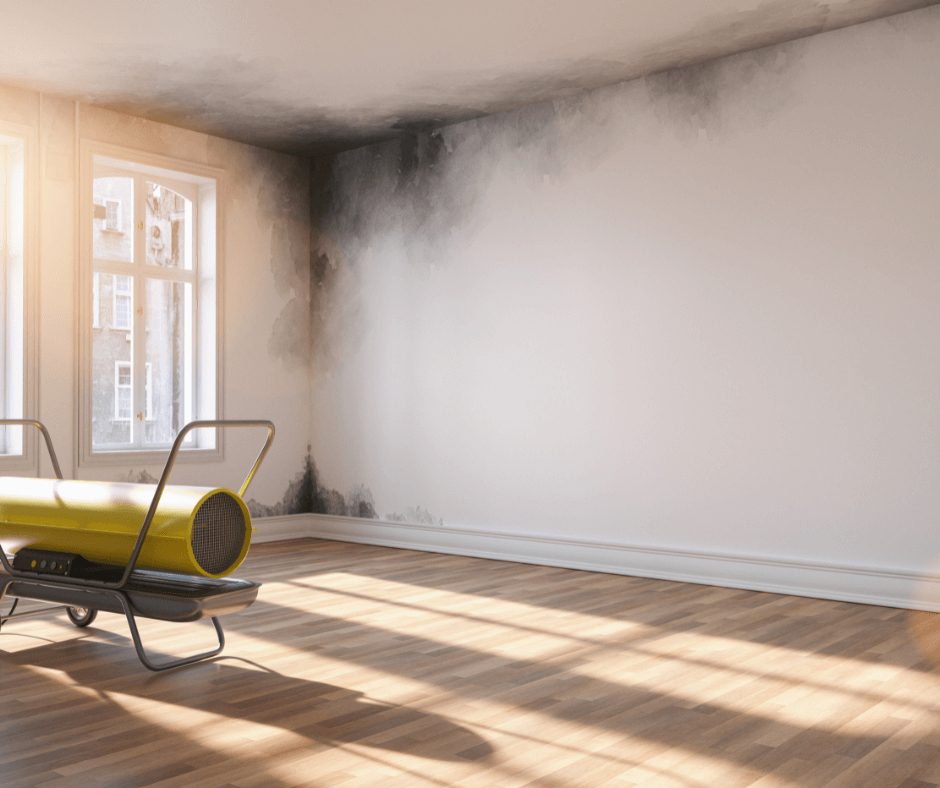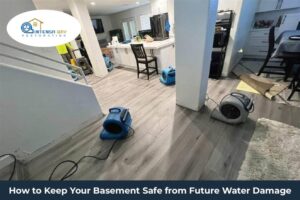Blogs
Fire Damage vs. Smoke Damage: Key Differences in Houston Homes

When it comes to dealing with fire damage in Houston homes, it’s important to understand the difference between fire and smoke damage. Fire damage is caused by the flames and intense heat, which can destroy structures and belongings. Smoke damage, on the other hand, results from the lingering soot and particles left behind after a fire. These particles can seep into walls, furniture, and even HVAC systems, causing long-term issues. At Intensa Dry, we specialize in addressing both fire and smoke damage, providing expert restoration services to ensure your home is safely and thoroughly restored.
What is Fire Damage?

Fire damage refers to the destruction caused by the intense heat and flames of a fire, affecting a home’s structure, belongings, and materials. It can result in burned walls, floors, and furniture, and sometimes even structural weakening. Fire damage restoration services focus on assessing and repairing the affected areas, including removing debris, cleaning soot, and rebuilding damaged structures. Professionals ensure a safe, thorough restoration, handling everything from smoke removal to complete reconstruction, to return your home to its pre-damage state.
Fire damage refers to the physical destruction caused directly by the flames and heat from a fire. When a fire ignites, it burns through materials, consuming everything in its path. The severity of the fire damage depends on several factors, including the intensity of the fire, the materials involved, the size of the affected area, and how long the fire burns.
Key Aspects of Fire Damage:
Structural Damage: The most significant impact of fire damage is often on the structural integrity of the home. Fire can weaken walls, floors, beams, and other supporting elements, potentially rendering the building unsafe. In severe cases, a fire can completely destroy the framework, making the home uninhabitable.
Burnt Belongings: Fire can quickly destroy personal items, including furniture, clothing, electronics, and valuables. Some belongings may be completely burnt, while others might only suffer partial damage depending on their proximity to the flames.
Melted or Distorted Materials: Extreme heat from a fire can cause materials like plastics, metals, and glass to melt or warp. This can result in further damage to both the property and any objects in the vicinity.
Fire-Related Chemicals: The combustion process releases harmful chemicals and toxins, which can contribute to long-term health risks for residents. These chemicals can linger in the air, surfaces, and materials long after the flames are extinguished, requiring specialized cleaning and restoration efforts.
What is Smoke Damage?

While fire damage is a result of the flames, smoke damage is caused by the smoke and soot that linger in the aftermath of a fire. Even if the fire doesn’t directly reach certain parts of the home, smoke can travel through air ducts, doors, windows, and even small cracks, depositing soot and causing damage to surfaces far beyond the fire’s reach. Smoke can affect a home’s walls, ceilings, fabrics, upholstery, and HVAC systems.
Key Aspects of Smoke Damage:
Soot and Residue: The most noticeable sign of smoke damage is the black, sticky residue left behind by the soot. Soot is made up of tiny carbon particles that cling to surfaces, leaving dark stains. It’s not just unsightly—it’s also corrosive and can damage materials like metal, glass, and wood. This residue often requires specialized cleaning to remove.
Odor: One of the most challenging aspects of smoke damage is the lingering odor. Smoke particles can settle in fabrics, carpets, and upholstery, and the smell often permeates deep into the structure of the home, including walls and insulation. This odor is notoriously difficult to remove and may require the use of ozone machines, air scrubbers, or even deodorization treatments.
HVAC and Air Quality: Smoke can infiltrate the air ducts and HVAC systems of a home, spreading soot particles throughout different rooms. Not only can this cause a further spread of damage, but it can also negatively affect indoor air quality, creating health concerns for residents. Cleaning and disinfecting the entire system is essential to restore air quality.
Health Hazards: Exposure to smoke and soot can have adverse health effects, especially if the affected area is not cleaned properly. Breathing in smoke particles or soot can irritate the respiratory system, exacerbate pre-existing conditions like asthma, and lead to other health complications. This makes addressing smoke damage just as important as repairing fire damage.
Key Differences Between Fire and Smoke Damage
Fire damage results from the direct heat and flames, causing structural destruction and burning of belongings. Smoke damage, on the other hand, occurs from soot, particles, and lingering odors that spread throughout a property. While fire damage often requires significant repairs or rebuilding, smoke damage involves thorough cleaning and deodorization. The long-term effects of fire damage on Plano properties include weakened structural integrity, potential mold growth due to water used in firefighting, and lingering health risks from toxic materials, requiring professional restoration to address all issues.
At first glance, fire and smoke damage may seem similar because they both occur as a result of a fire. However, understanding the distinct differences between them can help you determine the right approach to restoration. Let’s break down these differences:
Cause and Source of Damage:
Fire Damage: Caused by direct exposure to flames and intense heat. It primarily affects physical structures and materials in the home.
Smoke Damage: Caused by the soot, smoke, and gases produced by the fire. Smoke can travel beyond the area directly impacted by flames, affecting parts of the home that may not have been directly involved in the fire.
Location of Damage:
Fire Damage: Typically concentrated around the origin of the fire. This can include walls, floors, ceilings, and anything in the path of the flames.
Smoke Damage: Can affect areas far removed from the fire itself. Smoke can travel through ventilation systems, leaving residues on walls, furniture, and hidden areas.
Restoration Process:
Fire Damage: Often requires more intensive repairs, such as structural repairs, replacing damaged materials, and addressing any underlying electrical or plumbing issues. The restoration process may involve rebuilding parts of the home.
Smoke Damage: Requires thorough cleaning to remove soot, deodorization to eliminate odors, and air purification to improve air quality. Specialized cleaning methods, such as dry ice blasting or ozone treatment, may be necessary.
Severity of Health Risks:
Fire Damage: Health risks are associated with toxic fumes released by burning materials and structural collapse. However, once the fire is out, the immediate risks are lower compared to smoke damage.
Smoke Damage: Smoke inhalation can have long-lasting health effects, especially if the soot and particles are not properly cleaned from the environment. Prolonged exposure to smoke damage can lead to chronic respiratory problems.
Why Professional Restoration is Essential
Professional restoration is essential because experts have the knowledge, equipment, and experience to handle fire and smoke damage efficiently, ensuring thorough cleaning and proper repairs. Restoration involves not just cleaning soot and eliminating odors but also repairing structural damage and restoring affected areas. In cases of severe damage, reconstruction services are often needed to rebuild walls, floors, and other elements of the home. Professional teams can manage both restoration and reconstruction, ensuring your home is safely and effectively restored to its original condition.
Whether you’re dealing with fire or smoke damage, the restoration process is not something to be taken lightly. Both types of damage require specialized knowledge and equipment to address effectively. While some homeowners might attempt to clean up fire or smoke damage on their own, it’s crucial to call in professionals who have experience with both types of restoration.
FAQs
What is the difference between smoke damage and fire damage?
Fire damage is caused by the direct heat and flames from a fire, which can destroy structures, belongings, and materials in its path. Smoke damage occurs from the soot and particles left behind by the smoke, which can travel and affect areas far from the fire. While fire damage requires structural repairs, smoke damage typically involves cleaning, deodorizing, and air purification to restore the affected areas.
What is the difference between smoke and fire?
Fire is a rapid chemical reaction that produces heat, light, and often flames, typically resulting from the combustion of materials. Smoke is a byproduct of fire, made up of tiny particles, gases, and soot released into the air during the burning process. While fire causes direct damage through heat and flames, smoke can spread and damage areas far from the origin, leaving residue and lingering odors.
How would you describe fire damage?
Fire damage refers to the physical destruction caused by the heat, flames, and intense temperatures of a fire. It can affect the structure of a home, weakening walls, beams, and floors, and destroy personal belongings and materials in its path. The damage may also include melted or warped items, as well as the release of harmful chemicals and toxins during combustion.
How to tell if something is smoke damage?
Smoke damage can be identified by the presence of dark, sticky soot residue on surfaces like walls, ceilings, and furniture. A strong, lingering odor of smoke often accompanies the damage, especially in fabrics and upholstery. Additionally, smoke particles may have infiltrated HVAC systems or air ducts, spreading the damage throughout the home.
Can you have smoke damage but no fire?
Yes, smoke damage can occur without a fire if there’s an event like a small electrical malfunction, a cooking accident, or even a malfunctioning heating system that produces smoke without flames. In such cases, the smoke can still spread throughout a home, causing soot residue and odors. However, the damage typically won’t be as severe as when a fire directly involves the structure or belongings.
Final Thoughts
Understanding the key differences between fire and smoke damage is essential for homeowners in Houston to properly address these issues. Fire damage directly affects your home’s structure and materials, while smoke damage can infiltrate hidden areas, leaving behind soot and lingering odors. Both types of damage require immediate attention and professional restoration services to ensure that your home is fully restored and safe to live in.
If you’ve experienced fire or smoke damage in your home, don’t wait—contact Intensa Dry for expert restoration services. Our experienced team is here to guide you through the process and help bring your home back to its pre-damage condition. With our professional expertise and advanced equipment, you can trust that your home is in good hands.

